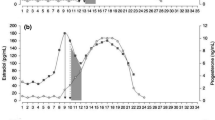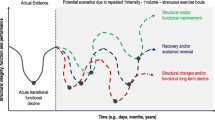Summary
Alpha-adrenoreceptors were determined as an equivalent to3H-dihydroergocryptine (DHE) specifically bound on intact thrombocytes in five untrained volunteers (I), eight non-staticly trained sportsmen (II), and eight intensively staticly trained athletes (III). Bmax was 933±363 (I), 982±373 (II), and 1796±539 fmol DHE·10−9 thrombocytes (III). KD was 1.28±0.49 (I), 2.94±1.12 (II), and 3.58±1.07 nmol·1−1 (III). The number of binding sites per cell amounted to 561±202 (I), 589±224 (II), and 1078±323 (III). The thrombocytes of the staticly trained athletes showed a significantly higher number of binding sites and a slightly higher affinity (KD) than the other groups (p < 0.01). However, a wide range of overlapping has to be considered. The biologic significance of these results and their transferability to other organs are open at present. It is the question whether an altered adrenoreceptor density may be one factor of a higher prevalence of hypertension in staticly trained athletes on which our research group has reported recently.
Similar content being viewed by others
Abbreviations
- Bmax. :
-
maximale spezifische Bindung des Radioliganden, basierend auf dem Scatchard-Plot
- KD :
-
Dissoziationskonstante ermittelt aus der Scatchard Analyse
- VO2 max. :
-
maximale Sauerstoffaufnahmefähigkeit
- DHE:
-
Dihydroergocryptin
Literatur
Alexander RW (1978) Characterization of the human platelet alpha-adrenergic receptor. J Clin Invest 59:1136–1144
Barthel W, Markwardt F (1974) Aggregation of blood platelets by biogenic amines and its inhibition by antiadrenergic and antiserotonergic agents. Biochem Pharmacol 24:37–46
Baumann G, Rieß G (1982) Verhalten kardialer β-Rezeptoren bei akutem Myokardinfarkt und chronischem Herzversagen. Mögliche Rolle von H2-Rezeptor-Agonisten im katecholamin-refraktärem Myokard. Herz Kreisl 14:169–178
Bieger W, Zittel R (1982) Effect of physical Activity on β-receptor activity. In: Knuttgen HG, Vogel JA, Poortmans J (eds) Biochemistry of exercise. Human Kinetics Publishers Champaign IL:715–722
Bristow MR, Ginsburg R, Minobe W, Cubicciotti RS, Sageman WS, Lurie K, Billingham M, Harrison DC, Stinson EB (1982) Decreased catecholamine sensitivity and β-adrenergic receptor density in failing human hearts. N Engl J Med 307:205–211
Butler J, O'Brien M, O'Malley K, Kelle JG (1982) Relationship of b-adrenoceptor density to fitness in athletes. Nature 298:60–61
Colucci WS, Alexander RW, Williams GH, Rude RE, Holman BL, Konstam MA, Wynne J, Mudge GH, Braunwald E (1981) Decreased lymphocyte beta-adrenergic-receptor density in patients with heart failure and tolerance to the beta-adrenergic agonist pirbuterol. N Engl J Med 305:185–190
Hertting G (1979) Das sympathische Neuron. Regelwege für Synthese Freisetzung und Wirkung des Tramitters. Klin Wochenschr 57:593–598
Hoffman BB, DeLean A, Wood CL, Schocken DD, Lefkowitz RJ (1979) Alpha-adrenergic receptor subtypes: Quantitative assessment by ligand binding. Life Sci 24:1739–1746
Lefkowitz RJ, Limbird LE, Mukherjee C, Caron MG (1976) The beta-adrenergic recptor and adenylate cyclase. Biochem Biophys Acta 457:1
Lefkowitz RJ, Williams LT (1977) Catecholamine binding to the beta-adrenergic receptor. Proc Natl Acad Sci 74:515–519
Lehmann M, Rühle K, Schmid P, Klein H, Matthys K, Keul J (1983) Hämodynamik, Plasmakatecholaminverhalten und β-Adrenozeptorendichte bei Trainierten, Untrainierten und Herzinsuffizienten. Z Kardiol 72:529–536
Lehmann M, Schmid P, Porzig H, Keul J (1983) Beta-Adrenozeptoren und Plasmakatecholaminverhalten bei Trainierten und Untrainierten. Klin Wochenschr 61:865–871
Lehmann M, Schmid P, Porzig H, Keul J (1983) Bestimmung von Beta-Rezeptoren an polymorphkernigen, intakten Leukozyten im autologen Plasma. J Clin Chem Clin Biochem 21:805–811
Lehmann M, Keul J (1984) Häufigkeit der Hypertonie bei 810 männlichen Sportlern. Z Kardiol 73:137–141
Macfarlane DE, Wright BL, Stump DC (1981) Use of (methyl-3H) Yohimbine as a radioligand for alpha-2-adrenoreceptors on intact platelets. Comparison with dihydroergocrytine. Thrombosis Research 24:31–43
Meurs H, van den Bogaard W, Kauffman HF, Bruynzell PLB (1982) Characterization of (−)3H-Dihydroalprenolol binding to intact and broken cell preparations of human peripheral blood lymphocytes. Eur J Pharmacol 85:185–194
Motulsky HJ, Insel PA (1982)3H-Dihydroergocryptine binding to alpha-adrenergic receptors of human platelets. Biochemical Pharmacology 31:2591–2597
Newman KD, Williams LT, Bisphoric NH, Lefkowitz RJ (1978) Identification of alpha-adrenergic receptors in human platelets by H-Dihydroergocryptine binding. J Clin Invest 61:395–402
Scatchard G (1949) The attraction of proteins for small molecules and ions. Ann NY Acad Sci 51:660–672
Author information
Authors and Affiliations
Additional information
Mit Unterstützung des Bundesinstitutes für Sportwissenschaft, Köln-Lövenich
Rights and permissions
About this article
Cite this article
Lehmann, M., Schmid, P., Bergdolt, E. et al. Ist die Alpha-Adrenorezeptorendichte an intakten Thrombozyten bei statisch trainierten Athleten erhöht?. Klin Wochenschr 62, 992–995 (1984). https://doi.org/10.1007/BF01728430
Received:
Revised:
Accepted:
Issue Date:
DOI: https://doi.org/10.1007/BF01728430




